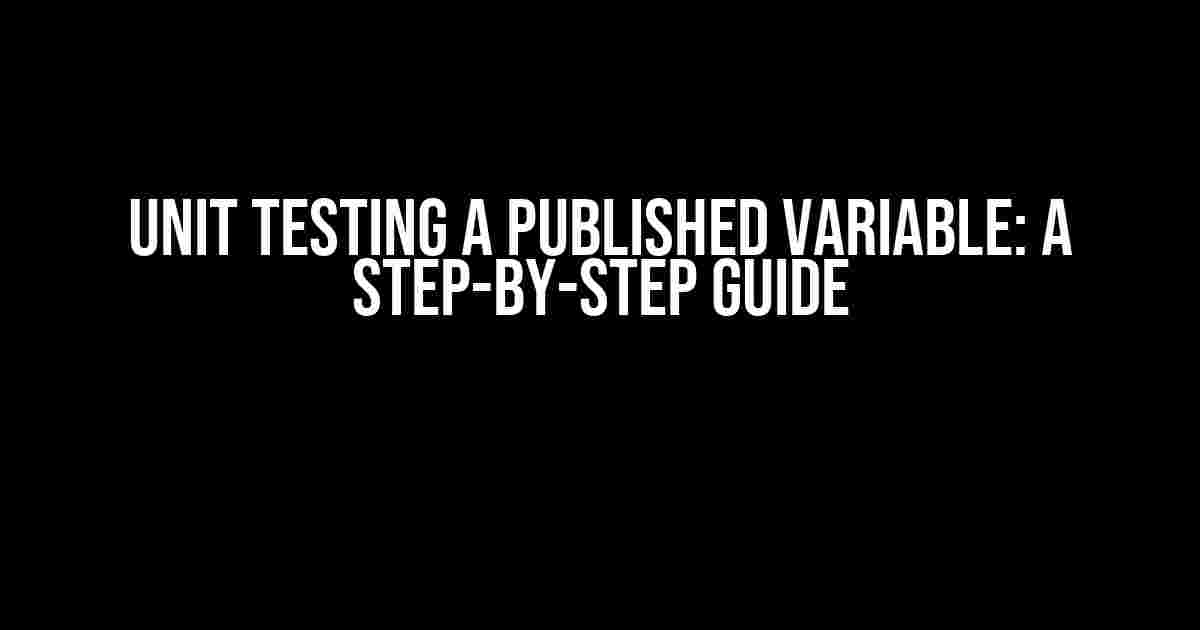As a developer, you know how crucial it is to ensure that your code is reliable, stable, and efficient. One way to achieve this is by unit testing your code, especially when it comes to published variables. In this article, we’ll delve into the world of unit testing and explore the best practices for testing a published variable.
What is a Published Variable?
A published variable is a variable that is exposed to the outside world, making it accessible to other components or modules. In other words, it’s a variable that is intentionally made public, allowing other parts of the code to interact with it. Published variables are commonly used in software development to share data between different components or to provide a way for external modules to customize the behavior of a component.
Why Unit Test a Published Variable?
Unit testing a published variable is essential for several reasons:
- Ensures Data Integrity: By testing a published variable, you can ensure that the data it holds is accurate and consistent, which is critical in many applications.
- Prevents Bugs: Unit testing helps detect bugs and errors early on, reducing the risk of introducing defects into your code.
- Improves Code Quality: Writing unit tests for a published variable encourages good coding practices, such as modular design and loose coupling.
- Saves Time: Catching errors early on saves time and resources in the long run, as you avoid debugging and fixing issues later in the development cycle.
How to Unit Test a Published Variable
Now that we’ve established the importance of unit testing a published variable, let’s dive into the step-by-step process of doing so.
Step 1: Prepare Your Test Environment
Before you start writing unit tests, you need to set up your test environment. This typically involves:
- Creating a new test file or class
- Importing the necessary libraries and modules
- Setting up any required dependencies or mock objects
// Example of setting up a test environment in JavaScript
import { MyComponent } from './MyComponent';
describe('MyComponent', () => {
let component;
beforeEach(() => {
component = new MyComponent();
});
// Your tests will go here
});
Step 2: Identify the Published Variable
Identify the published variable you want to test. This could be a property on a component, a global variable, or a value exposed by a module.
// Example of a published variable in a JavaScript component
class MyComponent {
constructor() {
this.publishedVariable = 'initial value';
}
}
Step 3: Write Test Scenarios
Write test scenarios that cover different aspects of the published variable. These could include:
- Checking the initial value of the published variable
- Verifying that the published variable is updated correctly when its setter is called
- Ensuring that the published variable is accessible from outside the component or module
// Example of test scenarios in JavaScript
it('should have an initial value', () => {
expect(component.publishedVariable).toBe('initial value');
});
it('should update the published variable when setter is called', () => {
component.publishedVariable = 'new value';
expect(component.publishedVariable).toBe('new value');
});
it('should be accessible from outside the component', () => {
const externalComponent = new ExternalComponent(component);
expect(externalComponent.getPublishedVariable()).toBe('initial value');
});
Step 4: Run and Refine Your Tests
Run your tests and refine them as needed. This may involve:
- Debugging and fixing any issues that arise during testing
- Refactoring your code to improve its testability
- Adding more test scenarios to cover edge cases or complex logic
Step 5: Integrate with Your CI/CD Pipeline
Once you’ve written and refined your unit tests, integrate them into your Continuous Integration/Continuous Deployment (CI/CD) pipeline. This ensures that your tests run automatically with every code change, providing instant feedback on the health of your code.
| Tool | Description |
|---|---|
| Jest | A popular testing framework for JavaScript |
| Mocha | A widely-used testing framework for Node.js |
| Pytest | A testing framework for Python |
Best Practices for Unit Testing a Published Variable
To get the most out of unit testing a published variable, follow these best practices:
- Keep it simple: Focus on testing the specific aspects of the published variable, avoiding complex logic or edge cases.
- Use mocks and stubs: Isolate dependencies and use mock objects to reduce the complexity of your tests.
- Write testable code: Design your code to be modular and easily testable, using design patterns like dependency injection.
- Test in isolation: Test the published variable in isolation, avoiding interactions with other components or modules.
- Use a testing framework: Leverage a testing framework to simplify the testing process and provide features like automatic test discovery and reporting.
Conclusion
Unit testing a published variable is a crucial step in ensuring the reliability and maintainability of your code. By following the steps and best practices outlined in this article, you can write effective unit tests that provide confidence in your code and help you catch errors early on. Remember to keep it simple, use mocks and stubs, write testable code, test in isolation, and leverage a testing framework to get the most out of your unit tests.
With this guide, you’re well-equipped to tackle unit testing a published variable and take your coding skills to the next level. Happy testing!
Frequently Asked Question
Get ready to uncover the secrets of unit testing a published variable!
What is the purpose of unit testing a published variable?
Unit testing a published variable ensures that the variable is correctly initialized and updated, and that its value is accurate and consistent throughout the application. This is crucial because published variables are often used to store and share data between different parts of the application, and any errors or inconsistencies can have far-reaching consequences.
How do I write effective unit tests for a published variable?
To write effective unit tests for a published variable, focus on testing the variable’s initialization, updating, and retrieval. Use mocking techniques to isolate the variable and test its behavior in different scenarios. Also, ensure that your tests cover both happy paths and error scenarios, and that they are independent and repeatable.
What are some common pitfalls to avoid when unit testing a published variable?
Common pitfalls to avoid when unit testing a published variable include not testing for edge cases, not isolating the variable correctly, and not considering the variable’s dependencies. Additionally, be wary of over-testing or under-testing, and make sure to test the variable’s behavior in different environments and scenarios.
Can I use a mocking library to simulate the published variable’s behavior?
Yes, you can use a mocking library to simulate the published variable’s behavior and isolate it for testing. Mocking libraries like Mockito or Moq can help you create mock objects that mimic the behavior of the published variable, allowing you to focus on testing the variable’s logic rather than its dependencies.
How do I integrate unit tests for a published variable into my CI/CD pipeline?
To integrate unit tests for a published variable into your CI/CD pipeline, simply add the tests to your test suite and configure your pipeline to run the tests as part of the build process. You can use tools like Jenkins, Travis CI, or CircleCI to automate the testing process and ensure that your published variable is thoroughly tested before deployment.



